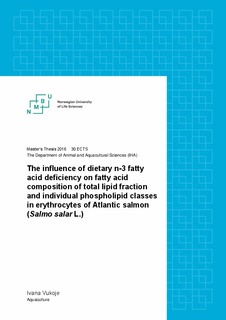| dc.description.abstract | While global population and its demand for seafood are constantly on the rise, aquaculture is facing a significant challenge how to provide safe and nutritious fish when fish oil supplies are decreasing. More emphasis has been placed on farmed Atlantic salmon since it is an important source of health promoting long-chain polyunsaturated fatty acids in human diet. To obtain good growth, health and ultimately high nutritional quality, Atlantic salmon requires essential fatty acids, mainly EPA (Eicosapentaenoic acid, C20:5 n-3) and DHA (Docosahexaenoic acid, C22:6 n-3). However, sustainable alternatives for fish oil in modern fish industry are lacking those fatty acids and therefore question imposes itself: what is the minimum inclusion of EPA and DHA in the feed that can secure good health and growth of Atlantic salmon and keep the production sustainable. Previous studies have shown that freshwater salmon has a minimum requirement of about 1 % EPA and DHA combined in the feed to maintain good growth. However, the requirements in seawater Atlantic salmon are yet to be established. Therefore, of great importance is to research and fully comprehend how low levels of EPA and DHA in the salmon diet influence fish health in different phases of the life cycle. This study is based on long-term feeding of Atlantic salmon from 40 g to 3,5 kg with low dietary EPA and DHA and focuses on changes, induced by dietary EPA and DHA inclusions of 0,2 % and 1, 7 %, on fatty acid composition of total lipid fraction and individual phospholipid classes (PC, PS, PI, and PE) in Salmon erythrocytes, during last phase of life cycle prior to slaughtering. Results show that Atlantic salmon fed with n-3 deficient diet, containing 0,2 % EPA and DHA combined, as a compensation for those fatty acids tends to accumulate AA (Arachidonic acid, C20:4 n-6) in erythrocytes and phospholipid fractions, especially in phosphatidylinositol (PI). Higher level of 20-carbon (n-6) fatty acids observed in fish fed n-3 deficient diet lead to low ratio between n-3 and n-6 fatty acids. In the end, those changes may disturb inflammatory status in the fish. Therefore, 0, 2 % inclusion of EPA and DHA combined in feed is not sufficient to maintain DHA status in erythrocytes of Atlantic salmon and this may have severe negative effects on fish health. | nb_NO |

